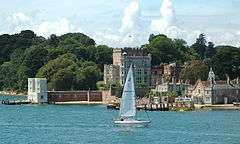Papillifera papillaris
| Papillifera papillaris | |
|---|---|
| | |
| Scientific classification | |
| Kingdom: | Animalia |
| Phylum: | Mollusca |
| Class: | Gastropoda |
| (unranked): | clade Heterobranchia
clade Euthyneura |
| Superfamily: | Clausilioidea |
| Family: | Clausiliidae |
| Subfamily: | Alopiinae |
| Tribe: | Delimini |
| Genus: | Papillifera |
| Species: | P. papillaris |
| Binomial name | |
| Papillifera papillaris (Müller, 1774) [1] | |
| Synonyms | |
| |
Papillifera papillaris, also known as Papillifera bidens, is a species of small, air-breathing land snail with a clausilium, a terrestrial pulmonate gastropod mollusk in the family Clausiliidae, the door snails. This is a Mediterranean species.
In Britain this species is now sometimes called the "Cliveden snail" because in 2004 it was discovered in the gardens of a well-known Buckinghamshire stately home which had previously been associated with the Profumo Affair.
Based on some recent research, it appears that there is a somewhat complicated nomenclatural problem with the name of this species. Apparently the name Turbo bidens was not originally applied by Linnaeus to material of this species. See further discussion under "Nomenclature".
Nomenclature
The ICZN opinion, number 2176, preserved the name Turbo bidens Linnaeus, 1758, and indicated implicitly that the name Helix papillaris Müller, 1774 was a junior synonym of the same species. However, at this time the meaning of the name Turbo bidens was not fixed with a valid type specimen designation. In 2009 Kadolsky [2][3] reviewed the nomenclatural history of the name Turbo bidens and concluded that a neotype designation proposed by Falkner et al. (2002) was invalid because it was not based on an existing specimen but on a figure of Papillifera papillaris published by Gualtieri (1742), which did not agree with Linnaeus' description of Turbo bidens, and which Linnaeus did not quote.
Kadolsky (2009) argued that Linnaeus' brief description was consistent with the figure of Gualtieri's work (1742) which Linnaeus (1758) did quote, and so Kadolsky fixed the meaning of the nominal species Turbo bidens Linnaeus, 1758 with the designation of a neotype. The neotype is a specimen from Florence (where Gualtieri lived and where he might conceivably have collected) of the clausiliid species hitherto known as Cochlodina incisa (Küster, 1876). However, the German malacologist Hartmut Nordsieck did not accept Kadolsky's interpretation.[4]
The main reason for this opinion, and indeed for the disagreement about the identity of Linnaeus' Turbo bidens since the inception of this name, is Linnaeus' description of the shell suture as "subcrenellate", which apparently does not apply to Cochlodina incisa. This is correct, except for minute crenellations which hardly deserve this name, but Nordsieck, and many authors before him, ignored the fact that Gualtieri's figure does actually show these crenellations. They are no doubt exaggerated, but Linnaeus accepted the figure as correct, and described his species accordingly. Kadolsky's neotype designation for Turbo bidens fixes the meaning of this name conclusively, and in consequence the valid name for the Papillifera species which has often been called Papillifera bidens, is Papillifera papillaris (Müller, 1774).
Shell description

The shells of Papillifera papillaris are left-handed and extremely high-spired, with 10–11 whorls.[5]
The width of the shell is 3.2–3.8 mm, and the height of the shell is 12–15 mm.[5]
The genus name Papillifera means "bearing papules", in other words having pimples, a reference to the small white shell structures along the suture line. The papules are very noticeable in the shells of individuals in this species.
Habitat
In most of its range, this species lives in rocky limestone habitats, and can often be found near the seashore.[5]
Distribution
The native range of this species is Mediterranean; it is originally native only to Italy, Sardinia, Corsica, and Sicily.[6]
This species has been introduced and has become established throughout the Mediterranean region, including the Balearic Islands, the South of France, Albania, Malta,[7] Croatia (Susak) and Turkey (since 330 AD or before).[8][9] At least some of these introductions appear to have been accidental, on imported stonework, and may in some cases date back to the Roman occupation of these areas.
In Britain
This snail was also accidentally introduced to southern Great Britain, more than once, and became established there.
In 2004, the species was found in Buckinghamshire, southeastern England, in the crevices of a travertine marble and brick balustrade. This balustrade was originally constructed in Italy in about 1816, and had stood in the grounds of the Villa Borghese, in Rome. In the late 19th century the balustrade was taken from there, and was installed in the formal gardens of the country house Cliveden in 1896. Since 1942, Cliveden has been owned by the National Trust.
These small snails shelter in the many nooks and crannies of the travertine marble stonework; presumably they feed on lichens that grow on the surfaces of the stone.
The snails at Cliveden were noticed by a specialist volunteer who was cleaning the stonework and statuary; the identity of the snail was recognized by Janet Ridout Sharpe, in a note in the 2005 Archeo+Malacology Group Newsletter.[10] The snails have spread from the balustrade to a red brick terrace and a stone fountain, but apparently no further than that. Although this is certainly an introduced species, it is not an invasive species.

Subsequent to the publicity surrounding this find, Chris Thain, the Reserve Manager of the Dorset Wildlife Trust, pointed out that the same species of snail was in fact already known from Brownsea Island, Dorset, in southwestern England, having been discovered 11 years earlier, in 1993, at which point the identity of the snail was confirmed by Michael P. Kerney of the British Museum. At Brownsea Island (as is also the case in Cliveden) the snails live in stonework and statuary which was imported from Italy in the late 19th century.[3]
This species was a new addition to the land snail fauna of Great Britain.
References
- ↑ Müller, O. F. 1774. Vermivm terrestrium et fluviatilium, seu animalium infusoriorum, helminthicorum, et testaceorum, non marinorum, succincta historia. Volumen alterum. - pp. I-XXXVI [= 1-36], 1-214, [1-10]. Havniæ & Lipsiæ. (Heineck & Faber).
- ↑ Kadolsky D. (2009). "Turbo bidens Linnaeus 1758 (Gastropoda: Clausiliidae) misidentified for 250 years". Journal of Conchology 40(1): 19-30. abstract.
- 1 2 Aydin Örstan. August 21, 2008. The old news about Papillifera papillaris from Cliveden. Snail's tales, http://snailstales.blogspot.com/.
- ↑ Nordsieck, H. "Papillifera bidens (Linné 1758) (Clausiliidae, Alopiinae), eine häufige, aber wenig bekannte Art". Link, accessed 26/05/11.
- 1 2 3 M. P. Kerney. 1983 Schnecken des mediterranen Frankreichs. page 297. In: M.P. Kerney, A. D. Cameron, J. H. Jungbluth. Die Landschnecken Nord- und Mitteleuropas. Verlag Paul Parey, Hamburg and Berlin. ISBN 3-490-17918-8, 384 pp. (in German)
- ↑ Papillifera papillaris. AnimalBase, last modified 20-10-2006 by F. Welter Schultes.
- ↑ Kolouch L. R. 2003. Suchozemští, sladkovodní a brakičtí měkkýši ostrovů Malty. Malacologica Bohemoslovaca, (2): 43-50. (in Czech)
- ↑ Aydin Örstan. March 2006. The clausiliid snail Papillifera papillaris in Istanbul, Turkey. The Archeo+Malacology Group Newsletter, (9): page 6-7.
- ↑ Burçin Aşkım Gümüş. December 2006. Additional data on the distribution of Papillifera papillaris (O. F. Müller, 1774) (Gastropoda: Pulmonata: Stylommatophora: Clausiliidae) in Istanbul, Turkey. The Archeo+Malacology Group Newsletter, (10): page 4-6.
- ↑ Janet Ridout Sharpe. March 2005. Papillifera papillaris (Gastropoda: Clausiliidae): a new record for Britain. The Archeo+Malacology Group Newsletter, (7): page 6-7.
- ↑ Falkner, Gernard; Ripken, T. E. J.; Falkner, M. (2002). "Mollusques continentaux de France. Liste de référence annotée et bibliographie". Patrimoines naturels 52: 1–350.
- ↑ Gualtieri, Nicolai (1742). Index testarum conchyliorum quae adservantur in Museo Nicolai Gualtieri [...] et methodice distributae. Florence: Caietano Albizzini.
- ↑ Linnaeus, Carl (1758). Systema naturae per regna tria naturae, secundum classes, ordines, genera, species, cum characteribus, differentiis, synonymis, locis. Vol. 1. Holmiae: Laurentius Salvius. pp. 824 pp.
External links
- Paul Eccleston. 21 August 2008. Italian immigrant snail was hiding in marble balustrade for 100 years. http://www.telegraph.co.uk/
- Snails pace discovery reveals amazing find. The National Trust website. (archived December 2011)
- Richard Black. 21 August 2008. Snail hides from march of history. BBC News website.
| Wikimedia Commons has media related to Papillifera papillaris. |

